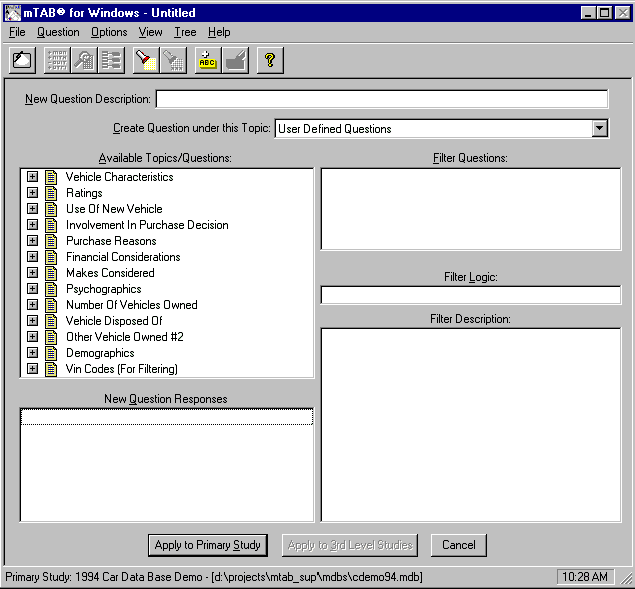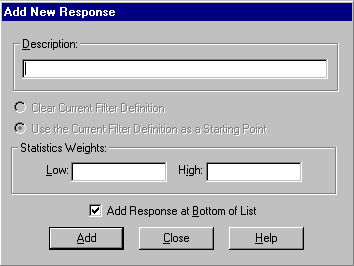Define New Question
Each question in an mTAB data set is associated with a table of responses. If
the response table does not suit the needs of a particular tab or report, the
responses can be combined using mTABs function. However, recode is limited to combining responses of a single
question. To overcome this limitation, mTAB allows you to combine multiple
questions to create a new questions that behaves exactly like a question provided in
the original data set.
Each new question response is defined by filter (a series of component questions and a Boolean equation). If a respondent
passes the filter for a given response, then that response will register as a hit
when the question is used in a tab run. Depending on the filter definitions,
multiple responses could be true for any given respondent. Therefore, the
defined new question takes on the characteristics of a multi-key question.
Steps to Define a New Question:
-

Select a primary study. From the Question Selection View, select Question|Define New Question
menu item or press the Define New Question toolbar button. This will launch
the Define New Question Editor view. This view is very similar to the question
selection view with the Questions tab on the left and the Filter tab on the right.

- Enter a description for the new question in the
New Question Description edit control. This field must be filled.
Select the topic under which the new question should be placed using the Create Question under this Topic combo box. By default the defined questions are placed in a new topic, User Defined Questions. This will be added as the last topic in the data set. If you wish, the new
question can be placed under any topic in the data set.
 Click inside the New Question Responses list box to give it focus. Begin adding new responses by choosing the Options|Add New Response
menu item, the Add New Response
right click menu item, or pressing the Add New Response toolbar button .
This will open the Add New Response dialog.
Click inside the New Question Responses list box to give it focus. Begin adding new responses by choosing the Options|Add New Response
menu item, the Add New Response
right click menu item, or pressing the Add New Response toolbar button .
This will open the Add New Response dialog.

- Enter the new response text in the
Description edit control. If this question is to be used to generate means, medians or
other statistical values, the Statistics Weights fields should be filled. The midpoint of the Low and High values will be
used to calculate means/weighted averages. Also, the range of Low and High values
will be used to interpolate medians. The new response will be added at the
current selected position in the list box unless the Add Response at Bottom of List check box is set.
If there were no new responses defined at the time you entered the dialog, two
radio buttons will be grayed out and disabled. Otherwise, you will have the
option to Clear the Current Filter Definition or Use the Current Filter Definition as a Starting Point. In many cases, the responses that make up a defined question will use the
same filter component questions with different subsets. By electing to Use the Current Filter Definition as a Starting Point, you can save the time of repeatedly selecting the same questions for each
response. Thus, it is better to add the first response, define its filter, and
then add the remainder of the responses using the first as a starting point.
A green check or a red X will be displayed in front of each new response as it
is added to the list. A red X indicates an incomplete filter definition.
Begin defining a filter by highlighting a new response. Select component
questions from the Available Topics/Questions list into the Filter Questions list. You must Subset each component question to create a valid filter. Finally, make changes to
the Filter Logic as needed. For more information see filters.
Repeat steps 6 and 7 until all new responses have been added and valid filters
have been defined for each.
The final step is to press either the Apply to Primary Study button or the Apply to 3rd Level Studies button. If 3rd level studies are not available, the latter button will be
disabled. The new question will be processed and written to an extension data
set (see Global Preferences, Environment / Network, MyDefined Questions). The extension data set will have the same name as the .MDB file with a
.DBX file extension. More than one extension data set may be created for a single
data set as long as the files reside in different directories. This allows
standard questions to be shared across a network (see Global Preferences, Environment / Network, Network Defined Questions).
 Extension Data Set Regeneration
Extension Data Set Regeneration

